A laptop screen or single monitor setup is adequate for most office tasks. However, day traders, programmers, digital artists, and other technicians often need more screen real estate. Such professionals rely on programs with expanded interfaces or multitasking software to get the job done.
Having two monitors can help maximize workflow and core engagement. But, such workstation setups need a lot of space. If you have a tiny computer desk, then your task becomes more daunting.
But is it impossible? Well, it all comes down to your technical flexibility, accessorizing, and a little ingenuity. This article covers a few hacks and furniture placements to ensure you can fit two monitors on a tiny desk and even have ample space to do other tasks.
Best of all, these tips and tricks are pocket-friendly. So, you won't have to splurge on loads of office accessories.
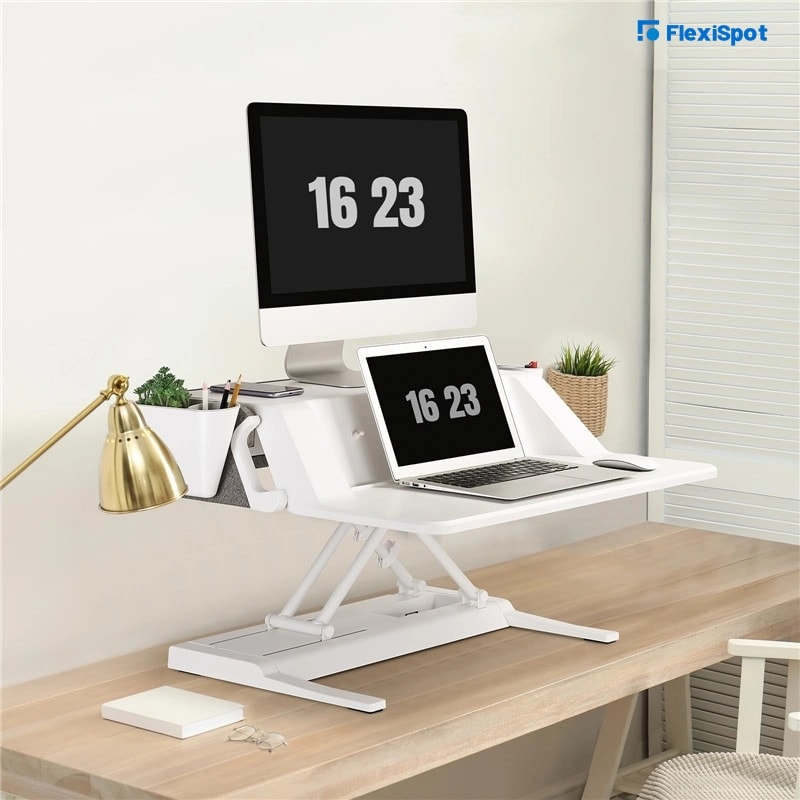
Monitor Stand Workstation to help declutter your desk
Let’s start by considering a person that would like to connect a monitor to a laptop. In such a case, a monitor stand could help you make the best of your limited desktop space. In such a setup, the monitor is raised to place your laptop in front of your screen. It does so without obstructing your view or pivoting your head too much. You also get to store books, documents, or any other tools in the compartments built within the monitor stand.
Such a setup solves the following issues:
Ensures you sit in a posture that doesn't harm your neck, back, and shoulders.
You get to maximize all the available desktop space.
All your computer screens are in full view to optimize your workflow.
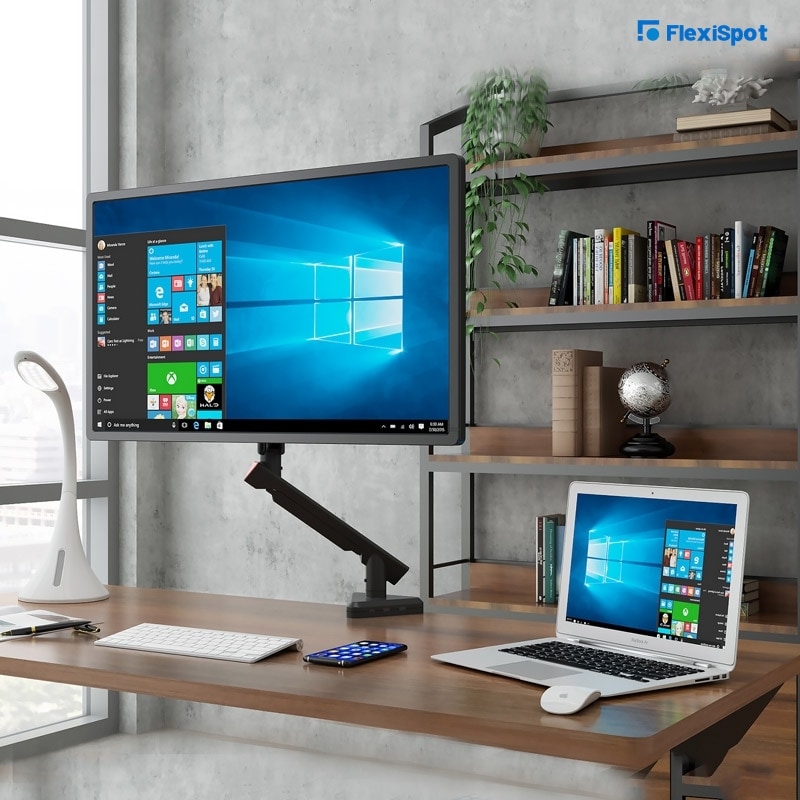
A Monitor Arm Frees Up Loads Desk Space
Monitor arms are the go-to solution when setting up two monitors on limited desk space. Such accessories come in all shapes and sizes and are widely available at various price ranges.
You can assemble a monitor arm within minutes and fix a screen right on the edge of a desk. This is because such mounts come with clamps or grommets that ensure your monitor is safe. Your computer screen remains tethered to the edge, which leaves most of your desktop free for other tools or activities.
Best of all, monitor arms support 360-degree rotation, which means you can position your screens in the following space-saving configurations:
Vertical
Most of the monitors available in the market have a longer width compared to their height. So, you could save a lot of space merely by opting to switch to vertical screen orientation. This move works when you fit on one or both screens vertically, then place them side to side.
From there, it's simply a matter of changing the display settings from a "landscape' to a 'portrait "orientation." It'll feel awkward at first, so you'll need some time to get used to the idea. But, such a setup is a sure-fire way to fit two monitors on a tiny computer desk.
V-Shaped
It may sound counter-intuitive, but you'd be amazed at how much space you can save by opting for a v-shaped dual-screen setup. All you have to do is place them side-by-side in the shape of a V and place your keyboard in the centre.
Doing so ensures that both monitors face you, and you don't have to tilt your neck or take your eyes off one monitor to look at what's going on on the other screen.
Your monitors, mouse, and keyboard occupy the middle part of your desk in such a setup. So, you get loads of space on the sides where you can place other work-essential tools.
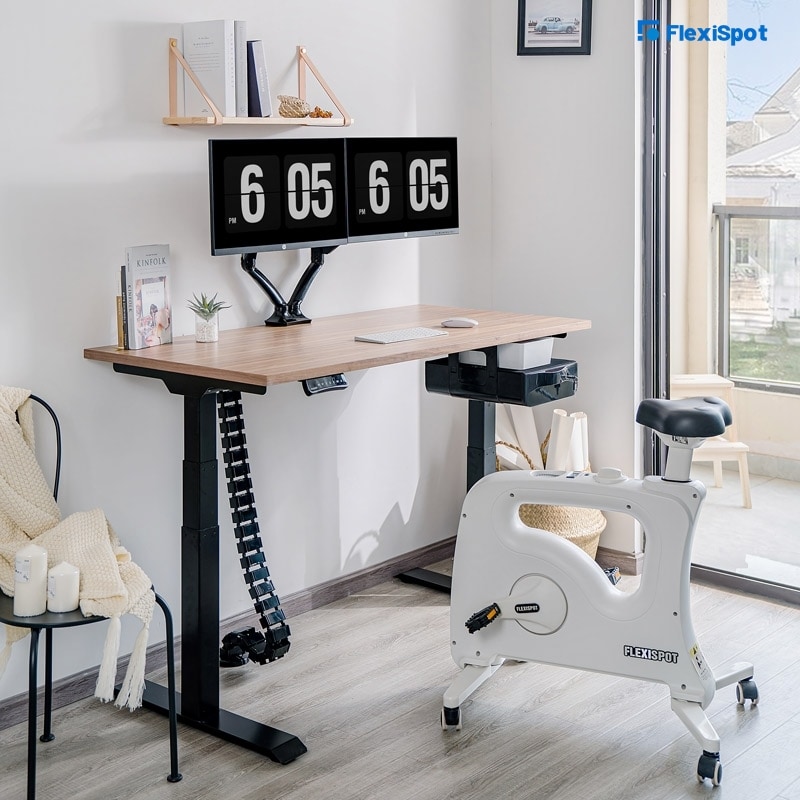
Office Practices to Help You Fit 2 Monitors on a Tiny Computer Desk
Managing the Desk Size
You can create more desktop space with DIY tricks if you have the necessary tools and a knack for home improvement.
The trick here is finding a block of wood or MDF board to add to the top of your existing tiny computer desk. Precision is of the utmost importance as you’ll need to cut a precise board and attach it with screws.
It would be best if you also found a solid piece of board that can support the rigours of daily use. But, you can skip this step by getting a pre-fabricated desktop. This will only leave you with the task of installing it on your existing desk. That way, you’ll expand your desk to fit more screens, tools, and work essential accessories.
Managing the Monitor Size
You can economize space with vertical, side-to-side, and V-shaped screen setups. However, this may not create enough space for other tools in some situations. And, you may not have the space to extend your desk or get a bigger one.
Does this mean there’s no hope? Well, it doesn’t as you could opt for smaller computer monitors that can fit better on your desk.
PC monitors come in various form factors (space displacements). These can range from 15-inches to beyond 26-inches. So, it's simply a matter of picking a computer monitor that works best with your current desk size.
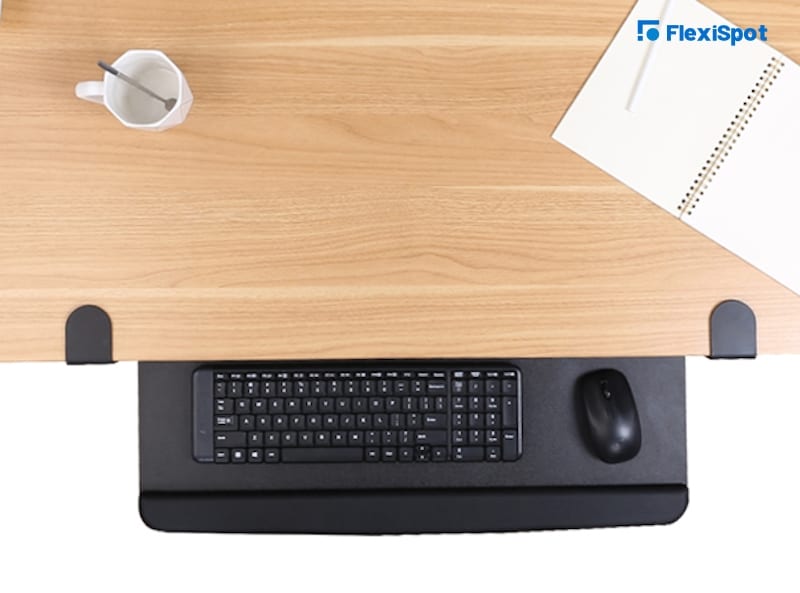
Mouse and Keyboard Placement
Most computer desks (especially the tiny ones) come with a drawer shelf that locks your mouse and keyboard in place. However, you may have to place your input devices on the table if your desk lacks such a feature.
This means you’ll have less space on your desktop. But, you can avoid such a situation by:
Going wireless –Bluetooth keyboards and mice often come in smaller sizes that occupy less space. They also don’t come with cables that clutter up your workspace.
Additional keyboard support –Clamp-on keyboard trays not only expand your desktop real estate. But, such accessories also place your keyboard closer to your office chair’s armrest. Such a measure ensures proper ergonomics for enhanced comfort and a lower chance of developing chronic muscular aches.
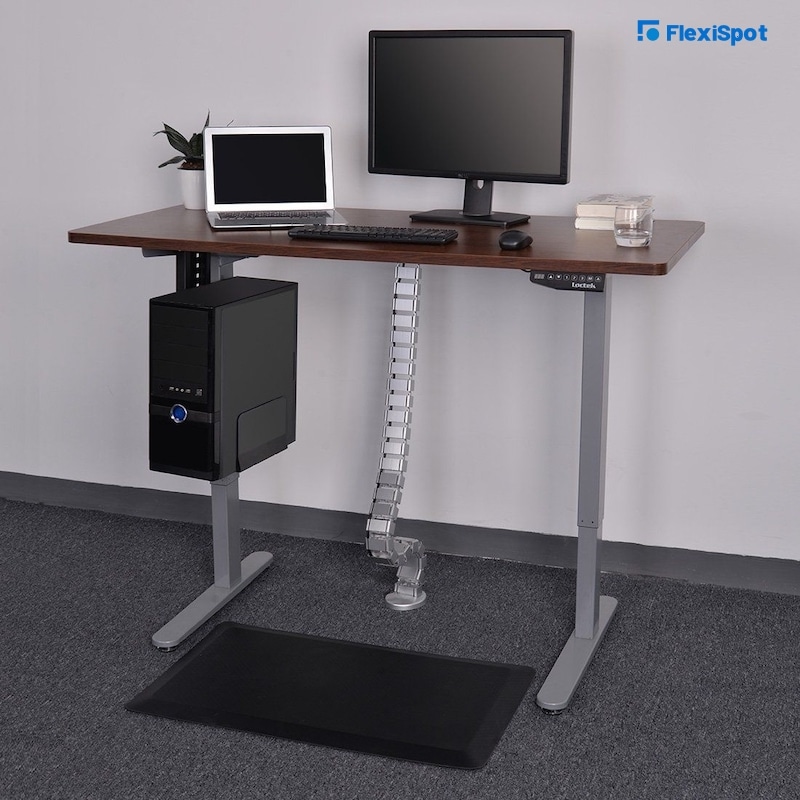
Cable Management
Cables are a nuisance that creates clutter hence "stealing" loads of valuable desktop space. Unfortunately, it's impossible to do away with cables, but you can use various cable management systems to reign in the chaos.
Here are a few cable management accessories worth considering:
1. A Cable Management Tray
A cable management tray is an attachment that you can screw or clamp to the back of your desk. It acts like a shelf that holds your extension cable off the floor. And you also tack in all your auxiliary wires to ensure they don't clutter your workstation.
2. Cable Management Kit Organizer
A Cable Management Kit Organizer Set offers the ultimate solution to the nightmare of cable clutter. It features various Velcro straps and zip ties that you can use to shorten the spread of cables. These ties come in multiple colours, so you can use them to enhance your décor. Or you can come up with a colour-coded system so you know where every cable goes.
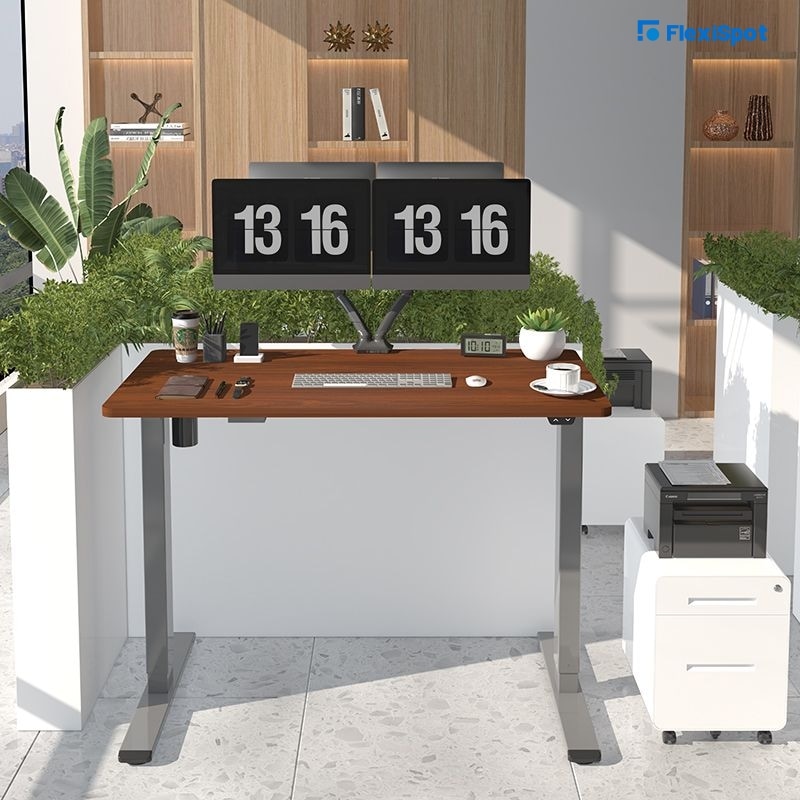
Additional Storage Space
A tiny computer desk doesn't give the luxury of spreading all your tools and documents on the surface. However, most people like to spread out their tasks in creative clutters on their desks to make paperwork and tools easier to access.
This can be counterproductive as you create more clutter as your tasks increase. The easiest way to deal with this is to get a desktop organizer. Or to opt for a lockable and portable file cabinet.
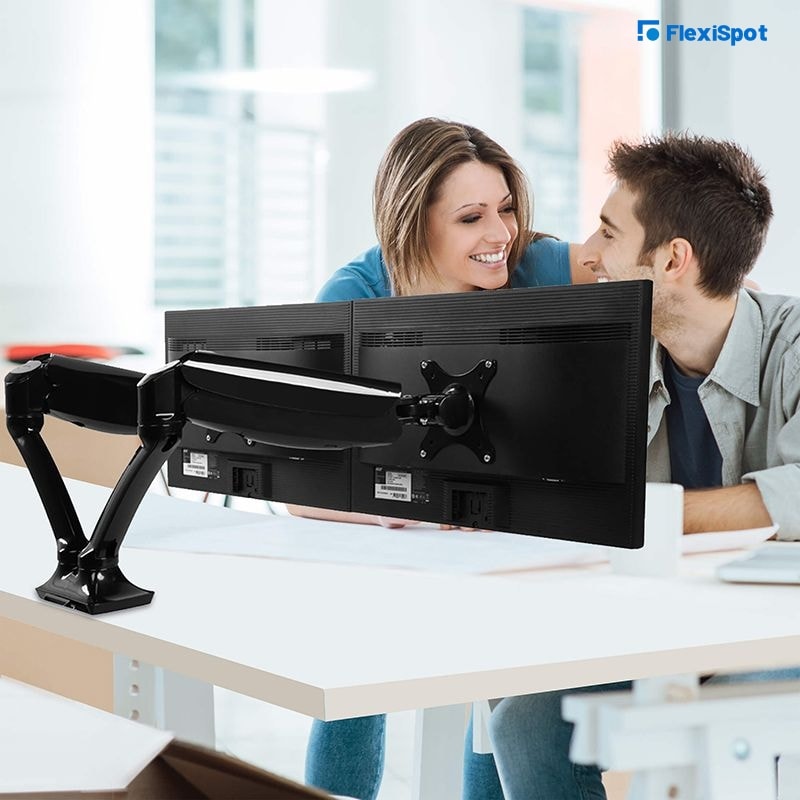
Precautions to Consider When Opting for a Dual Screen Setup
As you can see, these tricks offer an excellent way to get more use out of your tiny computer desk. However, there are a few precautions worth considering to avoid damaging your computer hardware, office furniture, or injury.
Therefore, processed with the following precautions in mind:
Ensure the wooden/MDF board on your desktop is stable and wide enough to support your monitor arm before installation.
Double-check the grommet or screws on your monitor arm after installation to ensure a firm grip on your desktop.
Make sure your computer desk is sturdy enough to hold the weight of extra tools.
Test to see if your desk can support all this additional weight before committing to the idea.
Ensure your desk sits on an even floor to prevent any wobbling. Use wobble wedges or improvise some from cardboard and place them under the desk legs to avert wobbling.

What is the Ideal Size Desk for a Two Monitor Setup?
It's hard to come up with a definitive answer to this question as there aren't any standards on desk sizing. Computer monitors are also available in different sizes, and their stands, frames, and casings also take up different amounts of space.
The size of your desk is pegged to the monitors you already have in use. Let's say you have two 21-inch monitors, and office space isn't an issue. Then an office desk with a 55-inch or larger desktop would be ideal.
However, if the desk is roughly the same size as your monitor, you have less space to fit all your accessories, let alone two monitors. In that case, it may be easier to upgrade your desk instead of going through the motions.
Conclusion
The benefits of a dual-screen setup are manifold. But, some desks are too tiny to hold more than one laptop, let alone two widescreen monitors. Hopefully, these few tricks and tips will work for the tiny computer desk you're using.
If not, then maybe it’s time to think of getting a height-adjustable desk. That way, you’ll be able to fit more screens and accessories into your workstation. Standing desks also allow you to stack other tools underneath and get proper blood circulation to ensure you’re more alert as you work.
We're passionate about standing desks, so we invite you to explore our blog and social media pages to learn more about them. We hope you'll consider getting one and that we'll see you in our next article.